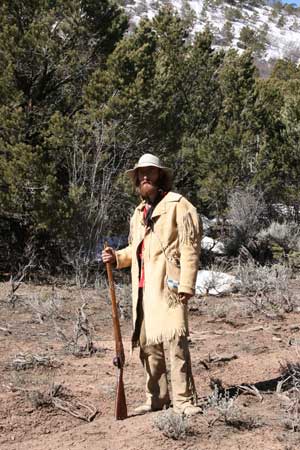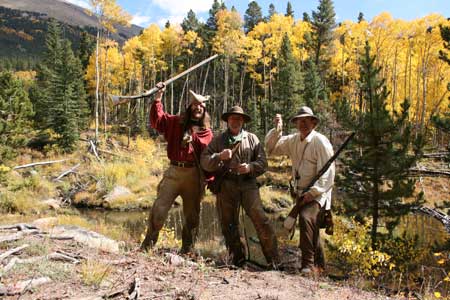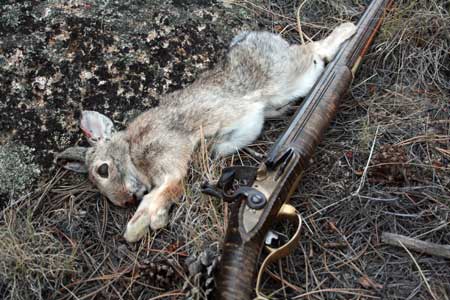Rocky Mountain Outfit — American Mountain Men (AMM) party of Colorado
Bradley C Bailey
My AMM Requirements
This is the documentation for the requirements that I have done to advance to a Bossloper member of the AMM. Officially I became a Pilgrim member of the AMM in January of 2008. It has been an incredible journey, and I have met many wonderful people along the way.
I officially became a Bossloper February of 2009. My number is #1980.
-
Must have a full set of hand-cut and -sewn clothing and handmade
accoutrements. These must be researched for authenticity of the 1800-40
period and be of a type which would have been seen on men in, or moving
to, the Rocky Mountains. Rifles, saddles, traps, blankets, and other
accoutrements that would normally have required the work of a specialized
craftsman need not be handmade, but must be as authentic as can be
purchased today.
My persona is that of a camp keeper for the American Fur Company in the 1830s. Since I am a camp keeper I do not carry traps.
I have spent a lot of time researching my clothing and other gear. I have used the images that Alfred Jacob Miller left behind as the basis for a lot of it, along with information found in fur trade inventories and descriptions that I have found in various journals.
All of my clothing and most of the rest of my gear has been made by myself and is hand sewn using period patterns and materials. I use wool and cotton fabric as well as braintan buckskin of my own manufacture. I primarily use backstrap sinew and linen or cotton thread.
 Spring Turkey Camp on 4/19/2008
Spring Turkey Camp on 4/19/2008
Sketched by Bill GanticAll of my clothing and gear is made by myself and is hand sewn using period patterns and materials. I use wool and cotton fabric as well as braintan buckskin of my own manufacture. I primarily use backstrap sinew and linen or cotton thread.
My pantaloons are made of braintan using a hide from the first deer I ever shot. They are of the narrow fall style and sewn with linen thread. The waistband is backed with canvas to prevent stretch. They have pockets at the side seams as well as under foot straps like those shown in the Miller paintings and descriptions of pantaloons from the period. My two main shirts are of red flannel, one heavy wool and the other cotton. They are of the basic drop sleeve pattern such as painted by Caleb Bingham. I wear my shirt tucked in as it doubles as underwear. In cold weather I wear a pair of white flannel drawers. My belt is 2" wide with a brass buckle. I keep my butcher knife in a simple tacked sheath tucked in the back. I have a knee length frock coat made from braintan elk with basic fringing and completely sewn with elk backstrap sinew. It is held shut with simple thongs and is of the common style of the 1830s and shown in many Miller paintings. Around my neck is a black silk handkerchief and a gage d'amour. I wear a grey wool low crown felt hat, though I also use a wolf ear cap of braintan in cool weather and to sleep in. The moccasins I use are either of the side seam pattern common to most western Indian tribes and painted by Karl Bodmer, or the pucker toe style with red wool inserts such as painted by A.J. Miller. I believe that moccasins are a disposable piece of clothing so I do not spend a lot of time during construction and I do not add extra soles. When I start to wear holes in the bottom I just stuff another piece of braintan inside as described by Wm. Drummond Stewart in Edward Warren. During cold weather I will use blanket liners or scraps inside of my moccasins. My shooting pouch is made from braintan elk with simple beadwork with blue and white pound beads. It is based off a painting by A.J. Miller titled "The Trappers starting for the Hunt". My horn is made from buffalo with pine plug and stained using tobacco. It is based off a horn at the Museum of the Fur Trade. I hang a bright oval fire steel on my belt so that I have one with me at all times. Inside of my shooting pouch is a small tin of char and some flints. I also carry a small burning lens inside of my gage d'amour so that I am always prepared to start a fire.
My camp consists of an 8' x 8' oilcloth which I hand sewed. I either set it up as a simple fly or lean-to, or lay it on the ground and wrap it around my blankets. The blankets that I use are hand woven blankets that I have purchased from Northwest Traders. My primary blanket is of the garanago pattern, or white with many thin red stripes. This type of blanket was depicted in many of Alfred Jacob Millers works as well as there is one listed in the 1836 RMO inventory list. I also have a 3 point white blanket with indigo broad stripes. Many of the blankets found in the inventories were white and smaller than 4 point in size.
Cookware is pretty simple. Usually either a small copper Hudson's Bay style kettle, or a tin one that is a little larger. One advantage of my copper kettle is that the lid can double as a frying pan since it is riveted. I rarely carry a frying pan, but I do have a small one with a folding handle. Besides the kettles I have a tin cup, which also doubles as a bowl. I do not carry a fork, but occasionally will bring a spoon. My butcher knife rounds out the cookware. Food is carried in small cloth bags.
I currently carry a 20 gauge smoothbore that was built and given to me by my grandfather. It is of a late 18th century Pennsylvania pattern. I think that it is possible that it would've made it to the west as guns were handed down through families and you would've used what you had. I have currently commissioned a custom J. Henry Lancaster rifle from Larry Walker et al and also plan to build a 24 gauge northwest trade gun.
Some of the resources that I have used in my quest:
- Journal of a Trapper, Osborne Russell
- Life in the Rocky Mountains, Warren Ferris
- Narrative of the Adventures of Zenas Leonard
- Wah-To-Yah and the Taos Trail, Lewis Garrard
- Rocky Mountain Life, Rufus Sage
- Edward Warren, William Drummond Stewart
- The West of Alfred Jacob Miller, Marvin C. Ross
- American Frontier Life: Early Western Paintings and Prints
- Rural Pennsylvania Clothing, Ellen J. Gehret
- Thoughts on Men's Shirts In America 1750 – 1900, William L. Brown III
- Various Fur Trade Inventories
-
Must have spent at least two days and one night in a primitive camp during
each season of the year.
Below is a subset of the camps that I have done during my year as a Pilgrim. I chose them because they were the main camps that we as a party did for each season.
Winter: January 18 – 20, 2008
Camped in a tipi along Ute Trail near Salida, CO. Also present were Bill Gantic, Vic Barkin, and Tom Karnuta. We packed our gear in using snowshoes and dragging gear on a tarp. There was about 2 feet of snow on the ground at the time and the temperatures dropped to below -10 F. Much time was spent in the tipi. I slept with 2 blankets and a buffalo robe. I used blanket scraps inside my side seam moccasins to keep my feet warm. We cooked buffalo tongue for dinner one night by boiling it. 3 days and 2 nights. The Summer 2008 issue of the Tomahawk & Long Rifle includes a write-up that I did about this camp.
View sketches from this camp. Fall 2008 Camp Members
Fall 2008 Camp Members
Spring: April 18 – 20, 2008
Spring turkey camp put on by Bill Gantic in the Escalante Canyon. Also present were Tom Karnuta and Bill Gantic. Unfortunately we were unable to make it to the planned destination due to the creek being too high to cross. We headed farther up the plateau and made camp in the trees. Found a single turkey breast feather, but other than that no turkey sign. No turkeys were taken during the camp, but we all had a good time. Night temperatures were in the 20s, daytime was nice and sunny. Slept with a single blanket. 3 days and 2 nights.
View sketches from this camp.Summer: June 28 – July 4, 2008 AMM Nationals
Traveled to the Big Hole in Montana with Bill Gantic and Tom Karnuta. This camp was a very special time for me as I got to meet many of the brothers and sisters. Having our camp surrounded with horses was something that I had never experienced before. We camped as a mess as usual for 7 days and 6 nights.
View sketches from this camp.Fall: September 26 – 28, 2008
Fall camp up in some beaver meadows in the Buffalo Peaks Wilderness area at above 10,000'. It was a 1 to 2 mile in. Also present were Tom Karnuta, and Dave McGlochlin (first time invite). We saw a moose, listened to elk bugling. I attempted primitive fishing, but was not very successful plus bait was hard to come by that high up. One evening it hailed and rained all night so we had no fire and ate dry goods for dinner. We successfully got a fire going in the morning even though everything was soaked. Ate venison and rice along with coffee. 3 days and 2 nights.
View sketches from this camp. - Must have spent an accumulative time of two or more weeks in the wilderness under primitive conditions in the company of no more than one other member. Each stay must be at least three full days and two full nights.
-
Must have spent at least one full week in a primitive encampment in the
company of other members at the territorial AMM Rendezvous (Eastern or
Western) and/or the National (Rocky Mountain) AMM Rendezvous.
I attended the 2008 AMM Nationals in Skinner Meadows, MT with fellow RMO members Bill Gantic and Tom Karnuta. 7 days and 6 nights.
View sketches from this trip. - Must be able to demonstrate the skills needed for primitive survival in the wilderness of his area and must be willing to teach said skills to other members when requested by a Party Booshway or Director of this Association.
-
Must be able to demonstrate trapping ability using steel traps, snares,
and traps made from natural materials found in the area. As many states do
not allow the use of some, or any, of these traps, the actual taking of
game is not required, although it is suggested where possible and legal.
Recreational trapping is not allowed in Colorado so I have not been able to take any animals using traps. I have however demonstrated the ability to create traps using natural materials. At one camp I showed Bill Gantic how to make a Paiute deadfall trap using cordage I made from locally available yucca. I have also made snares using cordage that I made.
- Must be able to demonstrate ability to track man or animal under natural wilderness conditions.
-
Must be able to demonstrate the ability to properly pack a horse, canoe
(or bullboat), or a man for distance travel under possible adverse
conditions.
I have demonstrated to others the method that I use to pack my gear upon my back. The way that I do it is by rolling it inside of my blanket and carrying it using a tumpline. My oilcloth is on the outside so if I am traveling in wet conditions my blankets and everything else will stay dry. I use this method because I feel it is one of the simplest to construct, and from materials that would have been readily available to the mountaineer that lost his horse or was forced upon foot for some other reason.
I currently do not have any experience with horses or canoes, but hope to be able to learn more about them and use them in the future.
-
Must be able to properly field dress (clean and skin) a game animal under
primitive conditions.
I have done this numerous times. On my Aux Aliments Du Pays camp during October of 2008, I dressed a rabbit using my barlow pocket knife. At other times I have dressed animals using my butcher knife. When working on larger animals I sometimes will use my hatchet to help split the ribcage and pelvis.
When skinning animals I use my knife very little other than for the initial cuts. For hides that I plan to tan I make cuts up the front of the front legs since it results in a better shape for the hide and is more historically correct.
-
Must be able to start a fire in wet, as well as dry, weather using flint
and steel or fire drill using tinder and wood found under natural
conditions.
I always start fire using flint and steel, although I have made numerous fires using a bow drill. Whenever I am at a camp I always look for local tinder to use. In my area I have used cottonwood, aspen, or juniper bark, various dried grasses, and pine needles. I have successfully started fires in wet conditions. During our Fall 2008 camp it rained all night and everything was soaking wet in the morning but I managed to get a fire going without any trouble. Sleeping with tinder and some kindling pays off. I also carry a small candle stub inside of my fire kit for times when it is wet, so that once I get my initial flame I can light the candle to help get the kindling to light. Some small pieces of pitch that I collect from trees, and a couple of small pitchy pine sticks which I can shave into slivers are also in my fire kit for times when getting a fire going requires a little more work.
One tip that I learned from Vic Barkin is to use my pipe as a blow tube by blowing through the bowl. This helps to concentrate the air flow on a fire and increase the heat.
-
Must be able to show ability to tan or Indian-dress hides.
Braintanning is something that I have been doing regularly since 2005. I am self taught, learning only from available books. I braintan about 30 deer hides per year. Some to sell, some to use for my clothing and gear. I frequently do demonstrations and teach others the skill and I have even taught classes at the Rocky Mountain College rendezvous. They even interviewed me on live TV in 2008.
- Must have spent at least five days traveling on foot, snowshoe, canoe, and/or horseback.
-
Must be able to cook a meal of meat using only the meat, fire, a knife,
and materials found in nature.
I satisfy this requirement nearly every camp I go to. I often cook and eat using only sticks. Meat can be skewered and propped up with a rock. Whole small game animals such as rabbits and squirrels can be cooked this way, or pieces of venison. My first AMM camp in September 2007 I cooked a marmot on a stick.
-
Must be able to converse using Plains Indians hand talk. The 200 words on
page 64 of Tompkin's book "Indian Sign Language", will be used as a basis
for conversation. To complete this requirement, you must demonstrate your
ability to read the signs for 50 words, as well as to give the signs for
50 words.
At the AMM Nationals in July 2008, I spent time taking the sign language college from Gene Hickman. After taking the college I successfully passed the sign requirement test that Gene gave me.
 Meat!
Meat!
I have also created an online resource for others to use in learning indian sign language. This required spending time comparing the sign information in the Tomkins and Clark books.
-
Must have hunted for and killed at least one game or fur animal with a
muzzleloading firearm or primitive bow and must have used the skin and/or
meat for food, clothing and/or accoutrements. The hunt must be made from a
strictly primitive camp, the hunt accomplished under primitive conditions
within the limits of local game laws.
During my solo Aux Aliments Du Pays camp in October 2008 I successfully hunted and killed a rabbit with my 20gauge smoothbore. I also passed up a pine squirrel and another rabbit that I did not need. I dressed the rabbit and cooked it on a spit. I did not save the hide as cottontail rabbit skins are too thin and tear too easily during skinning. The rabbit was the only meat I had during the camp and it was great!
I have had a great time working through these requirements, but it is not the last time that I do them. These are things that I do on a routine basis and I will continue to do so. I enjoy being out on the ground and challenging myself with different situations and learning or improving my skills.
Bradley C Bailey
November 8th, 2008